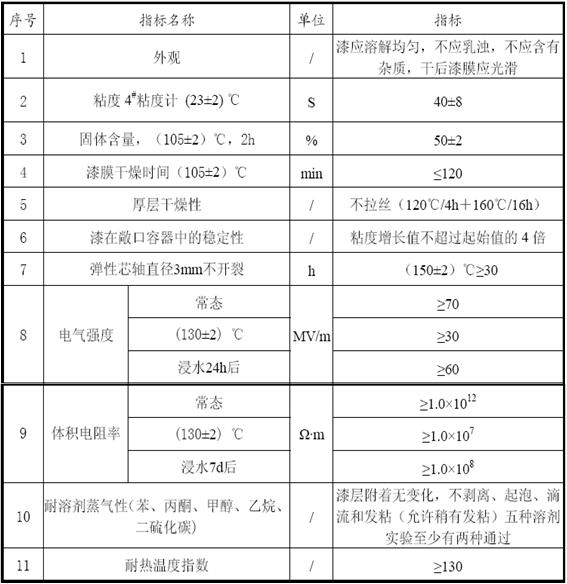Product Name:Insulating paint/varnish

ER2000Insulating paint/varnish
Product features
The heat-resistant grade is Class B, which has high dryness, thermoelasticity, oil resistance and high dielectric property. It is suitable for dipping motor and electrical coil. This product has high electrical performance.
Product advantage
● This product has superior electrical performance.
● The product has outstanding dry permeability, oil resistance, thermoelastic property and fast curing speed during use.
Application range
It is suitable for winding and insulation parts of B-class dipping motors, generators, transformers and other motors.
Performance index-implementation standard JB/T9558-1999
Application guide
The dipping and drying process is as follows:
Surface purification → pre-baking → first dipping → dripping paint → first baking → second dipping → second dripping paint → second baking
Surface purification: iron filings, oil stains and dirt will inevitably be mixed in the process of workpiece manufacturing. Blowers and other methods are required to remove various mechanical impurities and particles that may conduct electricity.
Pre-drying: Pre-drying shall be carried out before impregnation. The purpose of pre-drying is to remove moisture and volatiles from the inside of the work piece, and to make the work piece have appropriate temperature so that the insulating paint can easily penetrate. During pre-drying, the temperature should be gradually increased, and the temperature rise rate should not be more than 30℃/ hour. If the temperature rise is too fast, the moisture on the surface of the workpiece will evaporate quickly, making the moisture diffuse from the surface to the inside of the workpiece, thus it is not easy to discharge. The pre-drying temperature is 120 5℃. Pre-drying should pay attention to the exhaust, so that the moisture in the drying room can be discharged in time, but it should be
Keep the temperature.
First impregnation: this product is generally immersed. Lift the workpiece into the paint tank, and the paint surface does not reach the workpiece more than 20mm, so that there is enough pressure to make the paint liquid penetrate into all the gaps of the workpiece. The temperature of the workpiece before impregnation is 50-60 DEG C, the temperature is too high, and the insulating paint solvent is volatile; Low temperature, poor fluidity and poor permeability of insulating paint. The dipping time is about 15 minutes (adjusted according to the volume of the workpiece until no bubbles appear).
First drop of paint: Take out the workpiece soaked with paint and drop off the residual paint to avoid generating a large amount of volatile gas after entering the drying room. The dripping time should be more than 30 minutes.
First baking: the baking process is divided into two stages, the first stage is a low temperature stage, the temperature is controlled at 60-80℃, about 3 hours. At this time, if the temperature is too high, the surface of the workpiece will dry too fast, affecting the drying of the inner layer. The second stage is a high temperature stage. The temperature is controlled at 120℃ for about 8-12 hours, or at 150℃ for about 5-8 hours. The baking is finished when the insulation resistance of the workpiece to the ground is above 6 megohms and is stable at the same value for 3 consecutive hours. The drying room must have a forced ventilation system to prevent burning and explosion during baking. The drying door should be able to be automatically opened when the internal pressure increases suddenly to ensure safety. Exhaust gas is led out of the room through pipelines to avoid excessive combustible gas in the room and explosion hazard.
Second impregnation: after drying, the workpiece is cooled to 50-60℃ for second impregnation. The purpose of secondary impregnation is to increase film thickness and improve workpiece performance. Immersion time is 3-5 minutes, too long will damage the paint film formed by the first invasion and drying.
The second drop of paint; The dripping time should be more than 30 minutes.
Second baking: the baking process is divided into two stages, the first stage is a low temperature stage, the temperature is controlled at 60-80 DEG C for about 3 hours; The second stage is a high temperature stage, the temperature is controlled between 120 and 150 DEG C, and baking is finished when the insulation resistance value of the workpiece to the ground is more than 10 megohms and is stable at the same value for 3 consecutive hours.
The viscosity of the paint in the paint tank will be increased due to repeated use or solvent volatilization due to lax sealing. ET1000 diluent can be used to adjust the required viscosity (coating -4 cups, 23℃, 20~35 seconds).

